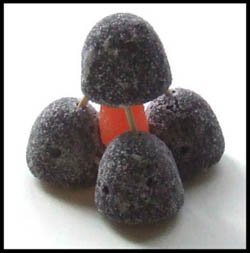|
Kids Science Newsletter #7
Why do leaves change color in the fall?
Hi,
This Kids Science Newsletter includes a question of the month, current science events, science trivia and a simple science experiment.
Question of the Month
Why do leaves change color in the fall?
(answer follows the simple science experiment)
Science Current Events
- Online Computer Games Help Science
- Scientists created a game called Foldit to help them solve the puzzle of the structure of proteins.They invited people to play the game and solve the mystery of how proteins form their structure. More than 57,000 people played the game. The players playing the game were more successful a program specifically designed to figure out how the structure of proteins grow. Maybe you will get a chance to play a game for science in the future on some other topic.
- The Turtle Rescue is a Success
- The last batch of turtle hatchings at NASA's Kennedy Space Center have been released. A total of 278 sea turtle nests were moved when they were endangered by the Gulf Coast oil spill. Over 15,000 hatchlings have been released from 28,000 eggs. The slightly more than 50% success rate is slightly more than in the wild where raccoons and other animals prey on the eggs and hatchlings.
- Cows With Names Produce More Milk
- Scientists have recently proved what some dairy farmers have known for many years that if you give milk cows some TLC (tender loving care) they produce more milk. Bessie, a cow, with some TLC will produce an average 68 gallons more milk over a 10-month period than other cows. The average milk production for a cow is 1,981 gallons in 10-months. See if you can figure out the total the cows that had tender loving care produce.
- Marine Census Report due October 4th
- For the past 10 years scientists have searched the oceans to discover and study unknown animal and plant life in our oceans. Scientists have documented more than 5,600 new species in the last 10 years and it is estimated that another 100,000 have not yet been discovered.
Science Trivia
- Caterpillars that crawl around must be muscle bound because they have more muscles than a human.
- Want to fry and egg on a sidewalk? If the sidewalk heats up to 158 degrees you might ask your parents if you can give it a try!
- California has lots of earthquakes but Iceland can boast it has icequakes!
- Brazil got its name from the nut, not he other way around.
- The bones of many birds do not weigh as much as the bird's feathers.
- Everyday astronauts orbiting the Earth get to see up to 16 sunrises and sunsets!
- The Asian vampire moth likes to drink the blood of animals.
- Gabriel
Simple Science Activity
3-D Molecule

Introduction
Quartz is part of a family of minerals called silicates. The silica tetrahedron is a basic building block of these minerals.
Materials
- Toothpicks
- Large gum drops
- Small spice drops
Directions
- Break a toothpick in half. Join 2 large gum drops together with 1/2 of the toothpick.
- Join a third large gum drop with the other half of the toothpick.
- Break another toothpick in half. Join the gumdrops together to make an equilateral triangle.
- Take a small spice drop and place it in the center of the 3 large gum drops.
- Place a toothpick in the top of each large gum so they come to a point in the center above gum drops.
- Press a large gum drop into the toothpicks forming a tetrahedron molecule with 4 equilateral triangles that surround the spice drop.
- Adjust the toothpicks as needed to form four equilateral triangles.
Science behind the experiment
Quartz is part of a family of minerals called the silicates. All silicate minerals contain the elements silicon and oxygen. Silicate minerals are the most common minerals in the Earth's crust and mantle. They comprise 95% of the crust and 98% of the mantle. The silica tetrahedron you just made is the basic building block of these minerals
Answer to the question of the month
Leaves change color in the fall because the leaves produce less sugar. As the season changes and there is less sunlight striking the leaves. The leaves during the spring and summer contain all of the colors but you can't see them because the process of photosynthesis that makes sugar for the plants turn the leaves green. When the leaves stop making sugar the green disapears from the leaves allowing you to see the other colors.
Easy Science Experiments
Science Activites
Home Page
Share the newsletter
Please feel free to share this newsletter with a friend by forwarding it to them. If you know of a group or other person who might enjoy the newsletter please let them know about it also.
Comments? Ideas? Feedback? I'd love to hear from you. Just reply to this Kids Science Newsletter and tell me what you think!
Sincerely yours,
Myrna Martin
|



